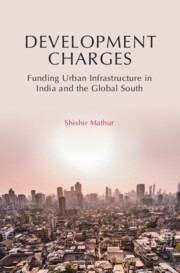Book contents
- Frontmatter
- Contents
- List of Figures
- List of Tables
- Foreword
- Preface
- List of Abbreviations
- 1 Introduction to Development Charges: Normative Bases and Their Role in Local Public Finance
- 2 Use of Development Charges Globally
- 3 Major Design and Implementation Considerations
- 4 Overview of Development Charges in India
- 5 Case Studies of Development Charge Programs
- 6 Recommendations
- 7 Way Forward and Future Research Opportunities
- References
- Index
4 - Overview of Development Charges in India
Published online by Cambridge University Press: 12 January 2024
- Frontmatter
- Contents
- List of Figures
- List of Tables
- Foreword
- Preface
- List of Abbreviations
- 1 Introduction to Development Charges: Normative Bases and Their Role in Local Public Finance
- 2 Use of Development Charges Globally
- 3 Major Design and Implementation Considerations
- 4 Overview of Development Charges in India
- 5 Case Studies of Development Charge Programs
- 6 Recommendations
- 7 Way Forward and Future Research Opportunities
- References
- Index
Summary
In India, revenues from taxes and fees typically accrue to the central government with little left for state governments and rural and urban local bodies (RULBs). Therefore, these two levels of government are fiscally constrained. Moreover, RULBs and state governments have very little authority to levy new taxes. In fact, local sources of revenue have steadily shrunk. For example, the recent implementation of GST necessitated local governments to discontinue octroi and local body tax. The abolishment of octroi led to a 35 percent reduction in the revenue of the Municipal Corporation of Greater Mumbai (MCGM), one of India’s largest municipal corporations (Mankikar 2018). Furthermore, the total government liabilities (sum of all government debt and liabilities) are over two-thirds (68.6 percent) of the country’s GDP (GoI 2020b), which restricts the amount of urban development funds the central government can award to the state governments and RULBs.
Moreover, due to underdeveloped municipal bond markets, local governments are unable to access private capital markets for raising debt to fund urban development. To date, only eight municipalities have raised a meager INR 33.9 billion (Das 2019) or USD 474 million. This amount is just 0.1 percent of the municipal bond issuances of USD 426 billion in the US in 2019 alone (SIFMA 2020). Finally, residents resist traditional local revenue sources, such as property taxes. In such a scenario, India’s local governments urgently need additional local revenue sources to fund urban development projects, especially due to their rapidly urbanizing populace. For example, between 2014 and 2050, India’s urban population will increase by 404 million, far exceeding the next two countries—China and Nigeria—that will witness increases of 292 million and 212 million, respectively (United Nations 2014). Development charges are a key potential revenue source (Chary and Prasad 2014; Civil Society 2018).
Starting in the 1980s and spurred by the balance of payment crisis of the 1990s, India initiated fiscal and economic reforms at the national level and started paying increased attention to neoliberal market-based solutions and revenue sources, such as development charges (Vidyarthi, Mathur, and Agrawal 2017). Other Global South countries are also exploring such solutions, which are being popularized by multilateral aid and lending organizations such as the World Bank and UN-HABITAT. Indeed, in 2016 UN-HABITAT published a reader for developing countries that provides an overview of such financing tools (UN-HABITAT 2016).
- Type
- Chapter
- Information
- Development ChargesFunding Urban Infrastructure in India and the Global South, pp. 72 - 88Publisher: Cambridge University PressPrint publication year: 2024

